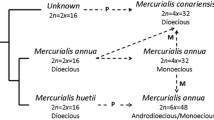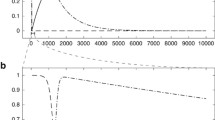Summary
1. The reproductive behaviour of a number of species and varieties ofRubus has been investigated.
2. Diploid species always behave sexually. Occasional unreduced germ-cells occur and take part in fertilization, giving rise to polyploid forms.
3. In polyploid forms and species reproduction may be entirely sexual, entirely non-sexual or partly sexual and partly non-sexual (apomictic).
4. Polyploid species vary in the degree to which apomixis is developed, and a particular species may show a variation in reproductive behaviour depending on the species used as male in cross-pollination.
5. Segregation has been found to occur within non-sexual offspring. Hence test crosses, in conjunction with cytological and embryological studies, are necessary to determine the precise mode of reproduction.
6. The results are discussed in relation to the difficult taxonomy ofRubus.
Similar content being viewed by others
References
Bailey, L. H. (1923).Quidam Rubi Cultorum. Gentes Herbarum, V. Pp. 155–56.
Crane, M. B. (1936). “Blackberries and hybrid berries.”R.H.S. Conference on Cherries and Soft Fruits, pp. 121–8.
Crane, M. B. &Darlington, C. D. (1927). “The origin of new forms inRubus. I.”Genetica,9, 241–78.
—— —— (1932). “Chromatid segregation in tetraploidRubus.”Nature, Lond.,129, 869.
Crane, M. B. &Lawrence, W. J. C. (1931). “Inheritance of sex, colour and hairiness in the raspherry,Rubus idaeus L.”J. Genet. 24, 243–55.
Crane, M. B. &Thomas, P. T. (1939). “Segregation in asexual (apomictic) offspring inRubus.”Nature,143, 684.
Darrow, G. M. (1933). “Cytology and breeding ofRubus macropetalus, the Logan, and related blackberries.”J. agric. Res. 47, 315–30.
Darrow, G. M. &Waldo, G. F. (1933). “Pseudogamy in blackberry crosses.”J. Hered. 24, 313–15.
Gustafsson, A. (1930). “Kastrierung und Pseudogamie beiRubus.”Bot. Not. 6, 477–94.
—— (1938). “Species formation and polyploidy within the apomictic generaRubus andTaraxacum.”Genetics,23, 149–50.
Hedrick, U. P.et al. (1925).The Small Fruits of New York. Albany, N.Y., p. 59.
Lidforss, B. (1914). “Résumé seiner Arbeiten überRubus.”Z. indukt. Abstamm.- u. VererbLehre,12, 1–13.
Lewis, D. (1939). “Genetical studies in cultivated raspberries. I. Inheritance and linkage.”J. Genet. 38, 367–79.
-- (1940). “Relation between polyploidy and fruiting habit in raspberries.”Proc. 7th int. genet. Cong. (in the Press).
Peterson, A. K. (1921). “Blackberries of New England.”Bull. Vt. agric. Exp. Sta. 218.
Author information
Authors and Affiliations
Rights and permissions
About this article
Cite this article
Crane, M.B. Reproductive versatility inRubus . Journ. of Genetics 40, 109–118 (1940). https://doi.org/10.1007/BF02982484
Issue Date:
DOI: https://doi.org/10.1007/BF02982484




